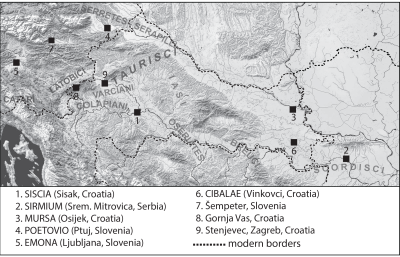
Cite this as: Leleković, T. 2018 How were Imitations of Samian Formed?, Internet Archaeology 50. https://doi.org/10.11141/ia.50.18
While working on my PhD thesis (Leleković 2012), on the topic of Roman burial archaeology of the Croatian part of Pannonia, I realised that locally made imitations of terra sigillata had an important role in the burial customs of the region. During the late first and early second centuries CE in the northern part of Pannonia and elsewhere, imported terra sigillata was often deposited in graves as grave goods (Marton 2008). At the same time, in southern Pannonia the most frequently used type of fineware for furnishing graves was a locally made imitation of sigillata. This was revealed by the excavation in the Roman town of Mursa, today the town of Osijek in Croatia, which was the core of my thesis. This phenomenon was even more intriguing given that almost all the imitations were burnished grey and black, significantly differing from terra sigillata originals. The quality of these imitations clearly indicated that such colouring was not a consequence of a technological deficiency, but a clear expression of local taste and demand. Imitations that were made subsequently, later in the second century, showed that the feature of black/grey slipped imitations of terra sigillata persisted in this region, obviously representing a distinctive alternative to the ever-present red gloss terra sigillata. In the later second century terra sigillata that was imported from Gaul and Germania was imitated so that relief-ornamented sigillata was copied with stamped PSW, while plain sigillata was represented by a wide range of PSW products. Some PSW imitations bear stamps of local workshops, which raises a wide range of questions regarding this production (Istenič 1999, 98, 102; Nagy 2014; Leleković 2016). Probably these stamps were not imitations of original stamps, but 'trade marks' of local Pannonian workshops.
Once these imitations were identified, a re-examination of other sites in the region and contextualisation of published material showed that this was not an isolated phenomenon. Burials from the same period throughout southern Pannonia showed that the use of imitations was common in all known cemeteries of that period. All discovered imitations were locally made, so that they can be considered as part of a regional ceramic group known as Pannonian slipped ware (PSW). There are several aspects of these imitations that can be explored, but the task of this article is to investigate why these vessels were made as they were by comparing the PSW finds with original terra sigillata found in the region to determine patterns in differences and similarities.

The development of local pottery production is directly connected with the process of urbanisation of southern Pannonia. The expansion of local groups and their distribution followed the spread of Roman towns after the province of Pannonia was founded in the mid-first century. Vespasian initiated the wave of urbanisation by founding the colonies of Siscia and Sirmium, and the municipalities of Andautonia and Neviodunum (Figure 1). Trajan continued this process by founding Poetovio, while Hadrian concluded it when he founded several new towns in Pannonia, among which was the colony of Mursa (Mócsy 1974, 113; Kovács 2014, 129, 135). This gradual development of the urban network is important for southern Pannonian pottery studies owing to the fact that it provides a defined timeframe. This would mean that no significant pottery production is to be expected before 70 CE: local ceramic groups should have emerged later during the Flavian era, or even in the time of Trajan. This assumption is confirmed by the fact that local imitations of terra sigillata have been found in archaeological contexts dating from Flavian times until the second half of the second century. Therefore, this article will focus just on this period, i.e. from the 70s CE until the 170s CE, as will be presented later in the text.
The importation of terra sigillata into Pannonia went through several phases defined by changes in the supply source. During the second half of the first century the Po valley was the main provider of terra sigillata, i.e. the Tardo-Padan group (Makjanić 1995, 43, 75). In the context of the late first century, South Gaulish sigillata is present only in small quantities: one sherd was found in Siscia (Makjanić 1995), and several vessles in Poetovio (Mikl-Curk 1969; Istenič 1999, 90-91). This is in accordance with the general assumption that South Gaulish terra sigillata was only marginally present in Pannonia. This is explained by the fact that terra sigillata was transported from La Graufesenque and Banassac to Pannonia through the Adriatic port of Aquileia, so it could never compete with the local northern Italian production (Gabler 1982, 51). More significant amounts of South Gaulish terra sigillata were found only in archaeological contexts of the Hadrianic period, represented predominantly by late production of Banassac. This would mean that during the reign of Trajan, transport routes over the Danube were finally secured and that goods from the west could be transported to Pannonia. The full potential of this route was realised in the late Hadrianic and Antonine periods when the supply of Pannonia was taken over by the workshops of Central Gaul. The dominance of Central Gaulish potters lasted until the 170s CE when workshops of Rheinzabern and Westerndorf become monopolies in the Danube region.
The logical consequence of importation of expensive fine tableware was the emergence of local production that tried to imitate imports both in appearance and in quality. In that regard imitations of terra sigillata can be observed throughout the Empire (Wells 1990). In some cases, such pottery is defined as distinctive ceramic groups, for example Wettereauer ware (Fasold 2006, 158 Grab X/2 Beilage 1,WW2), but in Pannonia imitations are considered to be part of a broader regional group known as Pannonische Glanztonware (Adler-Wölfl 2004) or Pannonian slipped ware (PSW). Pottery of this group is characterised by a burnished appearance, resulting from a fine paste and slip that were fired at the beginning of production, in most cases in a reducing atmosphere. Accordingly, the relatively heterogeneous ceramic group was developed, allowing the incorporation of several varieties of pottery that were previously recognised as separate local groups, the majority of which were imitations of terra sigillata (Adler-Wölfl 2004; Maróti 1987; Brukner 1981, 29-32; Istenič 1999, 91-103).
This article is primarily the result of research being conducted on material collected at the site of Osijek in eastern Croatia, which in Roman times was known as Mursa. Mursa is known as a veteran colony founded by Hadrian in 133 CE in the south-east part of the Roman province of Pannonia. Excavations from 2008 on Trg bana Jelačića in Osijek revealed a cemetery whose use, according to retrieved grave goods and its stratigraphy, can be dated before the foundation of the colony. Accordingly, discovered burials provide a sample of everyday objects in use at Mursa from the (late) Flavian period until 133 CE Furthermore, excavations conducted at several locations within the later colony of Mursa also revealed remains of the wooden structures that were in use during the first decades of the colony. Although the study of the collected finds is still being conducted, the absence of the later Rheinzabern production dates the use of these structures to after the foundation of the colony in 133 CE until the early 170s (Leleković 2008).
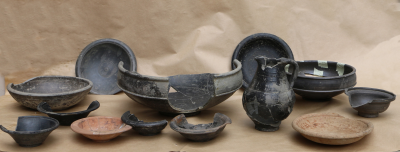
During excavations in Mursa a collection of well-preserved fineware vessels was compiled that provides a good sample for this study (Figure 2). According to the results of the excavations these finds can be chronologically grouped into two main stratigraphic horizons: pre-colonial phase (70s-133 CE) and the first 'wooden' phase of the colony (133-170s CE), which result in two differing chronological groups of material. Such classification of Mursa material corresponds to the general observation of the previously described chronology of the import of terra sigillata into southern Pannonia. Also, the pre-colonial cemetery corresponds to the time when terra sigillata was predominantly imported from northern Italy, with small additions of imports from Gaul that date to Flavian and Trajanic periods. The wooden colonial phase of Mursa, on the other hand, corresponds to the stage defined by the imports from Gaul dated from the 130s until 170s.
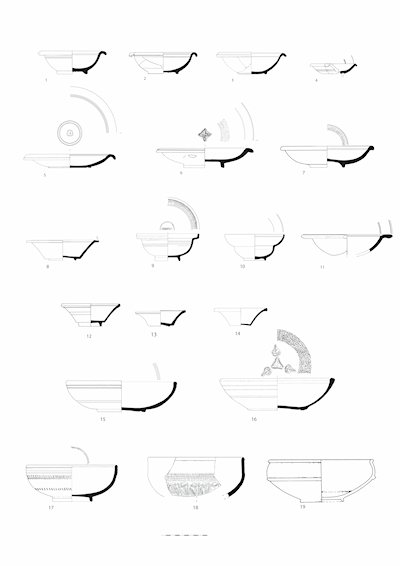
Besides the material from Mursa, this study includes material from some other south Pannonian regions that will be presented below. The dilemma with the published material is a certain inconsistency in how representative the data from the different periods may be. That is, this study includes 864 sherds and completely preserved vessels of terra sigillata and PSW, while the period before the 130s is represented by only 9 finds of terra sigillata and 110 of PSW, while 628 fragments of terra sigillata and 117 finds of PSW represent the period from the 130s-170s CE. The material of the Flavian and Trajanic periods in most cases derives from burials. This study includes 110 pieces of PSW from five cemeteries of that period: 35 vessels from Gornja Vas (31.8%), 23 from Mursa (Trg) (20.9%), 35 from Poetovio (31.8 per cent), 11 from Zagreb-Stenjevec (9.1 per cent) and 7 from Šempeter (6.4 per cent) (Table 1). It is problematic to fully validate this sample considering it consisted of finds entirely collected in burial contexts. It is impossible to determine whether the sample is representative of the types of vessel in everyday use at that period, or assemblages confined only to burial customs. Terra sigillata is mostly found in settlements, but imports from the late first and early second centuries are rarely found in southern Pannonia. The only available publication with imported sigillata during that time is that of Siscia material (Makjanić 1995). Remains of imports dating to the middle and second half of the second century are abundant throughout the region, but the material is mostly unpublished. Terra sigillata finds of that period, which are included in this study, have been analysed solely for the purposes of this study.
| Site | 70s-130s | 130s-170s | ||
|---|---|---|---|---|
| TS | PSW | TS | PSW | |
| Aquincum | 24 | |||
| Cibalae | 26 | 1 | ||
| Gornja Vas | 35 | |||
| Mursa (Park) | 72 | |||
| Mursa (Trg) | 2 | 23 | 602 | 20 |
| Poetovio | 5 | 35 | ||
| Šempeter | 2 | 7 | ||
| Zagreb-Stenjevec | 10 | |||
| 9 | 110 | 628 | 117 | |
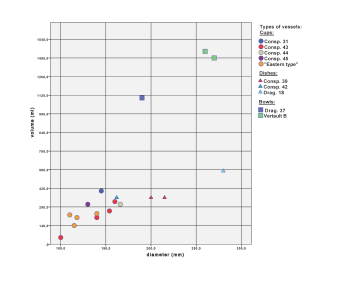
An additional reason why the Mursa material is the main reference in this article is the fact that excavation of a pre-colonial cemetery produced 35 complete PSW vessels that allowed rim diameter (DM), height, and volume of vessels to be precisely measured (Figure 3 & Figure 4, Table 2). Not all of these measurements could be found among the published material used for this study, i.e. the publications of Poetovio (Istenič 1999), Emona (Petru and Petru 1978), Gornja Vas (Gregl 2007), Stenjevec (Gregl 1989), and Šempeter (Kolšek 1976). In the majority of cases only the rim diameter is a constant, while other measurements are rarely stated. Additionally, quality drawings in publications do not provide enough data for this study. Nevertheless, published material from the region is used within the limits of its descriptions and accompanying illustrations.
| Pic. no. | Description | Context | Rim diameter (cm) | Height (cm) | Volume (ml) |
|---|---|---|---|---|---|
| 1 | Imitation of terra sigillata cup of type Consp. 43. Burned under reduced atmosphere. Slip of dark grey colour. (Designation: PN 4743) | Mursa. Pre-colonial cemetery. Grave 278 | 16 | 4.9 | 320 |
| 2 | Imitation of terra sigillata cup of type Consp. 43. Burned under reduced atmosphere. Slip of dark grey colour. (Designation: PN 2640) | Mursa. Pre-colonial cemetery. Grave 109 | 14 | 5 | 200 |
| 3 | Imitation of terra sigillata cup of type Consp. 43. Burned under reduced atmosphere. Slip of dark grey colour. (Designation: PN 5294) | Mursa. Pre-colonial cemetery. Grave 263 | 15.4 | 4.7 | 250 |
| 4 | Imitation of terra sigillata cup of type Consp. 43. Burned under oxidizing conditions. Slip of red colour.(Designation: PN 5296) | Mursa. Pre-colonial cemetery. Grave 189 | 10 | 4.8 | 60 |
| 5 | Imitation of terra sigillata dish of type Consp. 39. Burned under reduced atmosphere. Slip of light grey colour. (Designation: PN 5214) | Mursa.Pre-colonial cemetery. Grave 396 | 20 | 9.3 | 350 |
| 6 | Imitation of terra sigillata dish of type Consp. 39. Burned under reduced atmosphere. Slip of dark grey colour. (Designation: PN 4621) | Mursa. Pre-colonial cemetery. Grave 287. | 22 | 3.4 | 350 |
| 7 | Imitation of terra sigillata dish of type Drag. 18R. Burned under oxidizing conditions. Slip of yellow colour. (Designation: PN 3643) | Mursa. Pre-colonial cemetery. Grave 241 | 28 | 7.8 | 550 |
| 8 | Imitation of terra sigillata cup of type Consp. 44. Burned under reduced atmosphere. Slip of dark grey colour. (Designation: PN 5181) | Mursa. Pre-colonial cemetery. Grave 364 | 16.2 | 4.5 | 350 |
| 9 | Imitation of terra sigillata cup of type Consp. 45. Burned under reduced atmosphere. Slip of dark grey colour. (Designation: PN 2732) | Mursa. Pre-colonial cemetery. Grave 103 | 13 | 4.9 | 300 |
| 10 | Imitation of terra sigillata cup of type Consp. 31. Burned under oxidizing conditions. Slip of light yellow colour. (Designation: PN 4364) | Mursa. Pre-colonial cemetery. Grave 297 | 14.5 | 5.4 | 400 |
| 11 | Imitation of terra sigillata cup of type Consp. 44. Burned under reduced atmosphere. Slip of dark grey colour. (Designation: PN 2450) | Mursa. Pre-colonial cemetery. Grave 106 | 16.6 | 4.3 | 300 |
| 12 | Cup the "Eastern style". Burned under reduced atmosphere. Slip of dark grey colour. (Designation: PN 2733) | Mursa. Pre-colonial cemetery. Grave 103 | 14 | 6.1 | 230 |
| 13 | Cup the "Eastern style". Burned under reduced atmosphere. Slip of dark grey colour. (Designation: PN 2910) | Mursa. The first colonial layer. Nivelation layer (SU 141). | 11.5 | 5.7 | 140 |
| 14 | Cup the "Eastern style". Burned under reduced atmosphere. Slip of dark grey colour. (Designation: PN 3941) | Mursa. Pre-colonial cemetery. Grave 305. | 11.8 | 6.2 | 200 |
| 15 | Imitation of terra sigillata bowl of type Vertault B Burned under oxidizing conditions. Slip of red colour. (Designation: PN 4642) | Mursa. Pre-colonial cemetery. Grave 189. | 26 | 6.2 | 1450 |
| 16 | Imitation of terra sigillata bowl of type Vertault B. Burned under reduced atmosphere. Slip of dark grey colour. (Designation: PN 5370) | Mursa. Pre-colonial cemetery. Grave 288. | 27 | 6.8 | 1400 |
| 17 | Imitation of terra sigillata bowl of type Drag. 37. Burned under oxidizing conditions. Slip of red colour. (Designation: PN 3630) | Mursa. Pre-colonial cemetery. Grave 241 | 19 | 7.7 | 1100 |
| 18 | Imitation of terra sigillata bowl of type Drag. 37. Burned under reduced atmosphere. Slip of dark grey colour. (Designation: A-1200) | Cibalae (Vinkovci). Unknown context | 20 | * | * |
| 19 | Bowl of a Pannonian type Su 6 after Adler Wigg. Burned under reduced atmosphere. Slip of dark grey colour. (Designation: PN 342) | Mursa. The first colonial layer. Pitt (SU 141). | 32.2 | 21.5 | * |
The first examples of imitations of terra sigillata encountered in southern Pannonia are plates made in shapes Consp. 3, Consp. 4 and Consp. 20. The earliest dated example is an imitation Consp. 20 plate found in Siscia (Figure 5). It was discovered in layers dating to the time of Claudius (Leleković 2016), in a burned structure that was probably part of the fortress of Legio IX Hispana (Lolić 2003). An additional five plates were found in Poetovio (Istenič 1999, 91-93), again a site where a legionary fortress of the Legio XIII existed during the entire second half of the first century (Horvat et al. 2003). One further vessel was found on the small rural site of Zagreb-Stenjevec (Gregl 1989). Considering that the majority of both original sigillata plates and their imitations were found on sites of legionary fortresses, it can be assumed that the imitations of plates from the first century were products of legionary workshops made for the 'legionary community'.
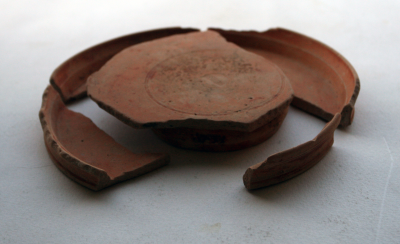
The analysis of burials included in this study showed that imitations of sigillata plates are not found in contexts from the late Flavian period onwards. Considering that these types of sigillata plates were more common in the mid-first century and that their production ceased at the beginning of the Flavian period (Ettlinger et al. 1990, 75-82), it can be speculated that PSW plates were made from the Tiberian period until the Flavian era, as a reflection of fashion and the fact that these plates were in demand during that period. This is substantiated with published terra sigillata finds from Siscia, among which plates of the form Consp. 20 predominate over other types of imported terra sigillata (Makjanić 1995).

According to Janka Istenič (1999, 92-94) the dimensions of locally made imitations of terra sigillata plate types Consp. 4 and Consp. 20 were made in two standard sizes: the larger ones with a rim diameter measuring 17.2-17.4cm and smaller ones with a rim diameter of 15.7-16.5cm. The sizes of the larger plates of PSW type in form Consp. 20 (Figure 6) match the smaller versions of the Italian prototypes of that time (Figure 7), whose diameters range from 17 to 18.5cm (Ettlinger et al. 1990, 82-87; Polak 2000, 75). This could be explained by the fact that terra sigillata plates that are clustered in several distinctive sizes (Figure 7) shows that production covers a longer time period, while these local products may have been made by only one potter for a short period of time.
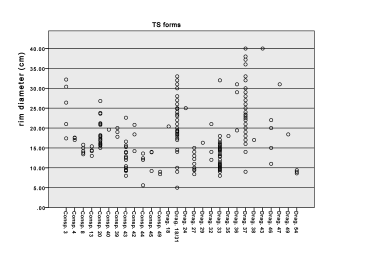
Considering that imitations of sigillata plates were found in such small numbers they are defined as sporadic occurrences, probably items that went out of fashion before the emergence of the first large settlements. It is hard to confirm whether the same could be said for the original terra sigillata plates. With further finds from the late first century it might be possible to establish when the demand for terra sigillata plates of type Consp. 20 ceased to be on the Pannonian market. If the production of imitations could be seen as an indicator of which types of terra sigillata (and its replicas) were in demand, then plates type Consp. 20 were out of fashion in Pannonia by the time of Trajan at the latest.
Terra sigillata changed in fashion during the Flavian period. Italian style terra sigillata was still the preferred type of tableware, but during this period workshops that were founded in the Po River region completely took over the market in the Danubian provinces. This northern Italian production, including an as yet unknown number of workshops throughout the Po valley, is also known as Tardo-Padana production (Zabehlicky-Scheffenegger 1990a), and introduced new forms and distinctive services onto the Pannonian market. These services consisted of different types of vessel, mostly cups and dishes of different sizes, whose rims were formed in the same way, so that they functioned as table sets. The use of these Italian services remained popular in Pannonia until the Hadrianic era, when fashion changed once more (Vernhet 1986, 98; Ettlinger et al. 1990, 50). Cups and dishes of Tardo-Padana production gained huge popularity in Pannonia, which can be observed on rare terra sigillata finds from that time (Brukner 1981; Makjanić 1995; Gabler 2003; Istenič 1999).
Cups are the most frequent form of imitation terra sigillata among finds included in this study. Although the modern term 'cup' is primarily associated with drinking (Dannell 2006, 151; this volume), in this article the term 'cup' is used to cover both cups (vessels used for drinking) and small bowls (vessels used in food consumption). Dannell has explained why it is hard to differentiate cups from small bowls, even according to their size.
As stated above, the production of terra sigillata during the second half of the first century is characterised by a change in fashion. Cups become the most popular form of terra sigillata, particularly those attached to Tardo-Padana Service A (Zabehlicky-Scheffenegger 1990b). Unfortunately, this period of change of fashion in southern Pannonia is represented by a rather small number of published terra sigillata finds of that type (Makjanić 1995, 56-61, plate 65) but a fuller sense of its popularity is indicated by the proportion of this type of imitation found in the region. Out of 110 vessels of PSW imitations collected from Flavian/Trajanic burials, 53 are cups of Consp. 43, while cups of other services are represented by one or two examples. Cups of type Consp. 43 are present on all sites included in this study, that is in Poetovio (Istenič 1999). Emona (Petru and Petru 1978), Mursa, Gornja Vas (Gregl 2007), Stenjevec (Gregl 1989) and Šempeter (Kolšek 1976). None of these finds were found in a settlement context – a problem already discussed in relation to this period.
Besides the vessels that imitate Italian style, there are other cups for which it is hard to determine the prototype. These cups are characterised by a sharp angle between the wall and the floor, a flat bottom and a concave wall. Typologically these cups are close to Italian forms Consp. 13 and Consp. 48, but these forms went out of use long before the Flavian period, so it is unlikely that they were used as prototypes (Figure 3, nos 12-14). These cups are also close to the form of Eastern sigillata B, namely the cup type Hayes 75 (Hayes 1985, 63, 68), to which these Pannonian products can equally be assigned (Gabler et al. 2009; Leleković 2016). A possibility that should also be considered is that these cups were made in the Gaulish style, indicating that cups of type Drag. 33 were imported to Pannonia as early as the Trajanic period. Although the problem of the origin of this shape remains unresolved, for now they are considered to be of 'Eastern' origin, assuming the influence of Eastern sigillata B on local workshops.
Cups imported from northern Italy had a rim diameter ranging from 10 to 14.5cm (Ettlinger et al. 1990, 128-33). Despite the fact that small versions of Consp. 43 cups were common in Pannonia at the time of Trajan (Gabler 1986, 33), only three imitations with a rim diameter less than 9cm are known, two of which came from Mursa cemetery (Figure 3, no. 4). These were made with a diameter of 8cm and could contain only up to 60ml (Figure 4).
Common PSW cups range in size from 10 up to 16.6cm in rim diameter (Figure 3, nos 1-3). Italian-type cups discovered in the Mursa pre-colonial cemetery were made in a more consistent size range. These PSW cups had a rim diameter from 13 up to 16.6cm (Figure 6). They could contain from approximately 140ml up to 280-300ml (Figure 4). Such volumes would correspond to the Roman unit of hemina: the lower limit of a container would correspond to half of a hemina (quartarius: 136ml), while the upper limit would correspond to a full hemina (273ml). In Mursa only one cup was found that was larger than one hemina. This is an example of a PSW cup type Consp. 31 (Figure 3, no. 10) that contains 400ml, but with its rim diameter of 14.50cm its size is consistent with that of the published originals (Ettlinger et al. 1990, 106-7). Cups that could contain more than this are also exceptional. Rim size and volume of 'the Eastern style' cups are close to those of the Italian style type. In rim size they vary from 11 up to 14cm, while one has a volume of one hemina (140ml) and three of 1.5 hemina (200-220ml) (Figure 4).
The fact that so-called cups could cover a broad range of functions may explain their prevalence among PSW imitations. Dannell has clearly shown that it is difficult to classify and define the function for a specific type of 'cup' (Dannell 2006, 160-62). The function of cups found in Mursa can be explored on the basis of their shape. The shape of rims and wall on cups defined as the 'Eastern type' makes these vessels ideal for drinking and as such they can be interpreted as drinking vessels (Figure 3, nos 12-14). On the other hand, the PSW cup made in the shape of Consp. 45 is certainly unsuitable for drinking and it should therefore be considered as a vessel form used to serve food (Figure 3, no. 8). Finally, cups of form Consp. 43 are suitable both for serving food and for drinking (Figure 3, nos 1-4). The fact that their use cannot be defined could mean that they may have been multi-functional. Their possible multi-functionality may have been the reason for their demand.
Reflecting once more on the article by Dannell (2006, 152-62), it cannot be concluded that size defines the function of particular types of cup, but it could be a good indicator (see also Dannell, this volume). The 'Eastern type' cups, probably used for drinking, are all small in size compared to other PSW imitations They can contain up to 200-300ml, or up to 5 cyathi – the basic measure for drinking (Dannell 2006, 158). Almost all other types of cup are much larger, with their volumes ranging from 300 up to 500ml. As such they may be seen as vessels whose shape would make them suitable for use in serving food (Figure 3, nos 8-11). Again, the cups of Consp. 43 type cover a wide range of volumes, from 60ml up to 320ml (Figure 4), which again could be an indicator of their multi-functionality. This group also includes two exceptionally small cups that can contain up to 60ml of liquid. Such cups of a similar size and shape are common in Pannonia among imports from northern Italian workshops for the first half of the second century (Ettlinger et al. 1990, 128; Gabler 1986). Considering the relation between the rim shape and the size of the container, they may be considered as unsuitable for drinking. These small cups were probably used to serve salt or spice at the table.
Dishes of type Consp. 39 have been found in all published cemeteries of that period, namely Poetovio (Istenič 1999), Emona (Petru and Petru 1978), Mursa, Gornja Vas (Gregl 2007), Stenjevec (Gregl 1989), and Šempeter (Kolšek 1976) (Figure 1), confirming that Service A was the most popular form of sigillata in southern Pannonia. It could be assumed, at least based on the example of the study of later Mursa material, that as a result of the fragmentation of individual vessels, it is sometimes difficult to differentiate cups from dishes. It can also be assumed that some authors had problems with defining the type of individual vessels, and defining type is also sometimes difficult to achieve solely on the basis of a drawing.
On the other hand, PSW dishes of Gaulish style are rare and found mostly in contexts of the second century. The only example of a dish that imitates Gaulish form is a dish of type Drag. 18R burned under a reduced atmosphere. It bears a yellow slip and its inner side is decorated with rouletting (see below).
Terra sigillata dishes of northern Italian origin were made with rim diameters ranging from 17.8cm up to 20.8cm (Ettlinger et al. 1990, 120-27). Two plates of type Consp. 39, although made of completely different materials and decorated in a different way, were almost the same size (Figure 3, nos 5-6). Their rim diameters were 20.00 and 21.5cm respectively and both vessels could hold 350ml of liquid. A dish of type Consp. 42 (Figure 3, no 8), typologically close to Service B, is smaller, with a rim diameter of 16.2cm. It is interesting to note that both dishes retained the same volume of 350ml, although it is questionable whether volume was an important parameter regarding their function. When the imitations from Mursa are compared with published originals it can be concluded that cups and dishes were made the same size as the originals, within acceptable margins.
PSW imitations of cups and dishes from other sites, and particularly from colonial layers of Mursa, show much greater variability in shape and size. Rim diameters of published PSW dishes of Service A range from 7.7cm up to 26cm, while PSW cups vary from 5.6 up to 24cm (Figure 6). Obviously, dish and cup sizes overlap significantly, which is not the case with the production of original terra sigillata.
The type Drag. 18R dish is also significantly larger than Italian type PSW dishes (Figure 3, no. 7), with its rim diameter of 28cm and volume of approximately 530-550ml (Figure 4).
Looking across all types of vessels published in the Conspectus (Ettlinger et al. 1990), the terra sigillata bowl was not a typical product of Italian production, but it was a product devised in the workshops of southern Gaul. Terra sigillata bowls should not be expected to be common until the first decades of the second century, given the dominance of Tardo-Padana production in the region. Nevertheless, some bowls have been found. It is reasonable to assume that terra sigillata bowls of type Drag. 37 were made even before the Flavian period (Dannell 2012). Early examples of Drag. 37 are extremely rare in southern Pannonia, but several vessels are known from colonia Siscia, made in 'OF COELI' and in the workshop of Biragus in La Graufesenque (Makjanić 1995, 63). Only 11 examples of PSW imitations of sigillata bowls are included in this analysis, forming around 10 per cent of the total number. Such a small share of bowls is expected, considering that this type of terra sigillata was still a novelty in Pannonia at that time, but it indicates that a new fashion was penetrating into Pannonia as early as the late first century. Early examples of Drag. 37 imitations have been found in graves of the late first and early second centuries in the south-west part of the province (Gregl 2007; Istenič 1999, 99), which is in accordance with such imitations of the same period from Carnuntum in the north-west part of Pannonia (Gassner 1993, 362-67). However, for vessels from Gornja Vas and Poetovio it is hard to determine the exact time of deposition – the late first or towards the middle of the second century. To conclude, terra sigillata of type Drag. 37 were known in Pannonia during the time of Trajan, so the existence of imitations of such bowls from that period is to be expected. Currently the only certified imitation of Drag. 37 is a bowl from the cemetery of Mursa (Figure 3, no. 17).
During the 130s and 140s this type of PSW imitation became dominant. It can be observed among the studied material from colonial layers in Mursa, but also in Cibalae (Figure 3, no. 18), Aquincum (Nagy 2014) and Siscia (Makjanić 1995, 72-73). In this later period of PSW production, imitations of Drag. 37 type were made in various modes ranging from plain undecorated vessels, those decorated with simple rouletting, by characteristic stamped decoration, or even with vessels made in moulds very closely resembling original relief-ornamented terra sigillata.
Despite numerous examples of this type of imitation, it was possible to inspect and measure the bowl from Mursa. The single specimen from Mursa cemetery is small, with a rim diameter of 19cm and volume of 1100-1200ml (Figure 4). It is not possible to determine the exact time of deposition for other Drag. 37 imitations deriving from burials, making it hard to establish chronological pattern differences among the collected vessels. Both large and small bowls of Drag. 37 imitations have been discovered, with rim diameters ranging from 11 to 28.4cm. An almost identical range of rim sizes is also evident among material found in colonial layers of Mursa, or in nearby town of Cibalae (Figure 1) (Figure 3, no. 18), and also from the capital of the Lower Pannonia Aquincum (Budapest, Hungary). All these towns produced imitations of Drag. 37 in various sizes. In most cases it was only possible to measure the rim diameter, which varied from 14 to 31cm (Figure 7), although the majority of bowls were made with rim diameters from 18 to 22cm (Figure 8). Along with Drag. 37 imitations, Mursa cemetery also produced two bowls from the early second century for which the closest parallel is bowl type Vertault B (Figure 3, nos 15-16). Both pieces are of a similar size with rim diameters of 27 and 28cm, but with significant difference in volume so that one could contain 550ml and the other 1400ml (Figure 4).
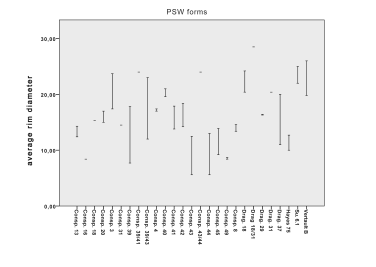
However, there is an unwritten assumption regarding terra sigillata: the later it is made, the larger it gets. A study was conducted of relief-ornamented sigillata bowls of type Drag. 37 from Cibalae, with rim diameters of 16.8 to 38cm (Leleković 2008). This study also showed that bowls made in Central Gaul before the mid-second century were predominantly smaller in size, with rim diameters from 20 to 24cm, while those coming from workshops of Rheinzabern and Westerndorf made later in the second century were much bigger. The rim diameters of these later vessels are up to 38cm. Although this rule on the growth in size of bowls is not immutable, it can be used as a guide for a more exact determination of which prototype was used for specific imitation, i.e. for the dating of a particular find.
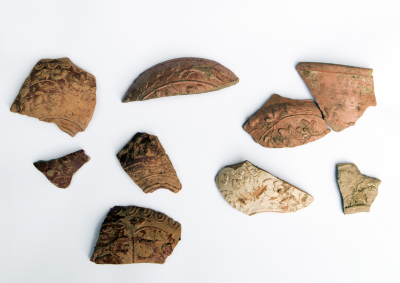
This rule can be substantiated by relief-ornamented imitations from the workshop of Pacatus, assumed to be inspired by products of the workshop of Cinnamus from Central Gaul (Kiss 1938, 212, 227) (Figure 9). The rim diameters of Pacatus Drag. 37 bowls varied from 18 to 22cm (Brukner 1981, plate 41) (Figure 6). Terra sigillata bowls made by Cinnamus were of identical size, so it can be concluded that Pacatus replicated imported originals as closely as he could. It is hard to determine what prototypes were used in the cases of other examples of PSW Drag. 37 bowls. When going by stamped ornamentation, it is also hard to determine whether these are bowl imitations of Central Gaulish production or later Rheinzabern production. Consequently, it is hard to put into perspective the size of these imitations. With an average rim size of 20-24cm it is possible to hypothesise that the peak of the local production of Drag. 37 bowls was the mid-second century, providing that all these bowls according to their size were imitations of Central Gaulish terra sigillata. The only bowls that could compete in size with Rheinzabern sigillata bowls are Kragenschüsseln of distinctive Pannonian shape (Adler-Wölfl 2004, 45-46), which can no longer be seen as an imitation of sigillata (Figure 3, no. 19).
Despite certain limitations in consistency and size of samples, it can be concluded that the median between original vessels of terra sigillata and their imitations is similar or even the same. This would mean that on average imitations followed the sizes of originals; cups were made with an average rim diameter of 14-16cm; dishes were made with an average rim diameter of 17.8-22cm; while bowls were made in an average size of 20 to 22cm (until the mid-second century). The aim of local potters seems to have been primarily to replicate terra sigillata in order to provide the market with cheaper versions of expensive imports.
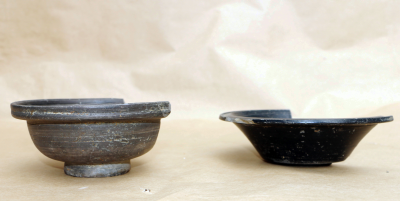
Second, although it can be concluded that the average size of the majority of the PSW vessels was within certain limits, their volumes and their sizes were not uniform. In some cases they varied by up to 50 per cent in volume (Figure 4). This is in line with a chemical analysis of all 32 PSW vessels from Mursa that produced an interesting outcome. Although the analysed material consisted of ceramics of different appearance, varying in fabric, size, type and style, they were products of only two workshops. This means that, although particular vessels can be typologically assigned to different terra sigillata groups and despite the fact that they were made in a different fabric, they were made in one workshop (Figure 2, Figure 10, Figure 11). It seems that use of a particular type was not of great importance. There was no deeper reason in forming a rim or a base in this way or that way. Probably, the function of a particular vessel was the main reason why some vessels were made in the form they were. If the function of a certain form was decisive, size and volume could be an important factor in their manufacture. The volume of vessels from the cemetery of Mursa shows that products were not formed following strict rules on size and dimensions, but that the part of the vessels that was supposed to contain liquids/solids could vary. Measurement of volume was done three times, using lentils as a means of measurement, and water when it was possible. On all occasions vessels were filled up to the incised line on the inner side of the wall, presuming that this line was a demarcation of a specific measurement unit. This experiment showed that this is in fact not so, but that the volume of solids and of water varied. This would mean that the line incised on the wall, at least where local pottery is concerned, had a purely decorative function or its function was to prevent the overspill of liquid. Obviously precision in manufacture, i.e. standardisation of size and volume, was of secondary importance.
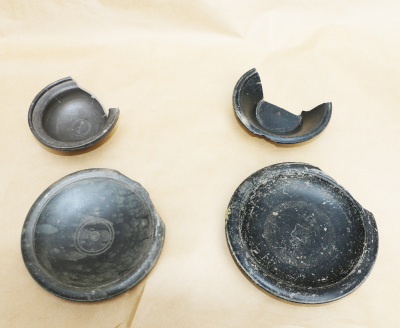
Thirdly, the analysis of a Tardo-Padana table set showed regularity in rim diameter. According to Conspectus and available publications, terra sigillata cups that were imported from northern Italy ranged in rim diameter from 10 to 14.5cm, while dishes ranged from 17.8 to 20.8cm (Ettlinger et al. 1990, 128-35). In a way, size is one of the deciding differing parameters between cups and dishes of the same terra sigillata set. The same cannot be established for imitations. Rim sizes of published PSW dishes range from 7.7cm to 26cm, while PSW cups vary from 5.6cm up to 24cm. So, in contrast to terra sigillata it is not possible to differentiate dishes and cups according to their rim diameters. This could be the result of two things. Firstly, in the majority of cases, finds are heavily fragmented, so it is hard to determine precisely the size of the rim diameter, and also in some cases it is difficult to determine whether an individual vessel is a cup or a dish. It is possible that, due to simplification of data, i.e. due to arbitrary determination of whether an individual vessel is a dish or a cup, this 'overlapping' of sizes can be an indication of corruption of data. The second explanation would assume that these data are correct. In that case, this could be explained by the fact that terra sigillata in the first and early second centuries was an expensive item, and as such the majority of imported sigillata was of a standardised size (if one can make a correlation between size and price). In contrast, imitations were easy to make and, as such, available for the general public to use. As the more economical type of ceramic, it was easy to make products of various sizes, even much bigger replicas than the originals that were imported to this same region (Figure 12).
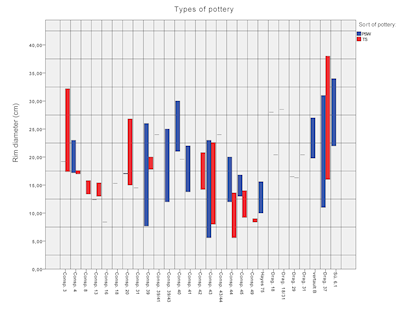
The question remains, what were the implications for food culture? The main obstacle in resolving these questions is that so little is known of food consumption in southern Pannonia. Recent excavation in Mursa showed that rice and pepper were used in everyday life, so it is reasonable to assume that town life did not differ significantly in Pannonia from parts closer to the centre of the Empire. In this regard it is clear that dishes of Tardo-Padana Services A and B, that became popular in Italy during the second half of the first century (Ettlinger et al. 1990, 46-47, 50), also gained popularity on the Pannonian market. This can be particularly observed for dishes of type Consp. 39 (Tardo-Padana Service A) (Figure 12). The precise function of these dishes is unclear. In modern terms these dishes are ideal for serving pasta or risottos. However, recent find of rice in Mursa that can be dated in the first half of the second century do open some questions in this respect. Nevertheless, both examples of Consp. 39 dishes from the Mursa cemetery were used as lids for large urns in which wine or beer was deposited in the graves, so it is possible that these plates also had a similar function in everyday use.
A more interesting question is related to bowls found in Trajanic burial contexts. Excavations in Mursa showed a shift in fashion that occurred in the middle of the second century. Layers that can be dated after 133 CE show a high proportion of imitations of terra sigillata bowls. From the second third of the second century onwards, imitations of bowls type Drag. 37 (Figure 3, no. 18) and bowls close to type Drag. 44 (Figure 3, no. 19) become common for PSW production. But in the early second century imitations of terra sigillata bowls are still rare. In Mursa cemetery only one example of bowl type Drag. 37 has been found (Figure 3, no. 17). It is red burnished and it is decorated only by chattering. This PSW bowl is found in a grave dated to the time of Trajan, and as such it is unique in the region. In a way it can be perceived as a forerunner of a fashion yet to come. These bowls were probably used for mixing wine, or as 'fruit bowls'. The only remaining type of PSW vessel found in Mursa cemetery is represented by two vessels defined in this study as bowls of type Vertault B (Figure 3, nos 15-16). The interpretations of two of these vessels are problematic because they do not resemble any particular sigillata shape. These hemispherical vessels can be defined both as deep dishes or shallow bowls. Both are decorated with rouletting and with stamped decoration. Similar types of PSW are found also in northern Pannonia, i.e. in Aquincum (Budapest, Hungary), where they are perceived as a mix of foreign influence and local Celtic traditions (Nagy 2014, 119-20). According to the quality of their production, their shape and their decoration they should be perceived as imitations of terra sigillata. Considering the time of their deposition I am inclined to relate these two dishes/bowls to South Gaulish dishes of type Vertault B (Passelac and Vernhet 1993; Delage 2010, 80-82). Interestingly these dishes closely resemble late Roman dishes of African production, i.e. of types Hayes 50B, Hayes 53B, Hayes 87B (Hayes 1972, 69-96). Of course it is not possible that these African dishes were used as prototypes, because these types were not made before the mid-third century. Its resemblance does open some questions regarding the provenance of these types, though. For example, these PSW imitations may have been imitations of the dishes Hayes 25 (Hayes 1972, 49-50). Dishes of this type are dated to the second century, and are typologically related to the above-mentioned dishes of types Hayes 50B and 53B. Also typological resemblance to dishes of the Eastern sigillata B of type 80 (Hayes 1985, 69-70), dated between 80-150 CE, yet again opens question of connections between PSW production and import from the East. It is hard to determine which kind of food was served in these bowls, but it is possible that pottery made in the eastern style may have been used for a type of food that also came from the East with colonisation of Pannonia. This is something that might be closely connected with the legions that were stationed along the Danube and populations of veteran colonies in this region, but on the current level of research these assumptions cannot be explored.
All things considered, it can be concluded that shallow bowls may represent a step towards development of large hemispherical terra sigillata bowls produced in the northern provinces after the mid-second century (Figure 3, nos 18-19). These 'shallow' hemispherical dishes/bowls prefigure large versions of dishes of type Drag. 18/31 and bowls of types Drag. 37, and consequently signs of change in food culture in this part of the Empire.
Internet Archaeology is an open access journal based in the Department of Archaeology, University of York. Except where otherwise noted, content from this work may be used under the terms of the Creative Commons Attribution 3.0 (CC BY) Unported licence, which permits unrestricted use, distribution, and reproduction in any medium, provided that attribution to the author(s), the title of the work, the Internet Archaeology journal and the relevant URL/DOI are given.
Terms and Conditions | Legal Statements | Privacy Policy | Cookies Policy | Citing Internet Archaeology
Internet Archaeology content is preserved for the long term with the Archaeology Data Service. Help sustain and support open access publication by donating to our Open Access Archaeology Fund.